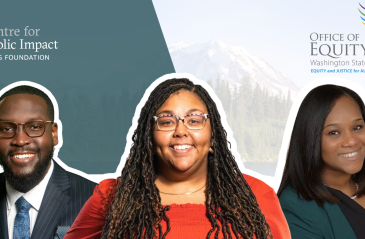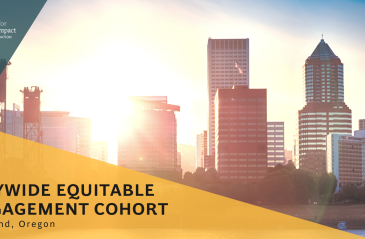
Five things we recently learned about difficult conversations

In the long fight for #marriageequality in Australia, three groups combined forces to achieve change: @AMEquality, government and business.
Share articleDespite overwhelming community support, #marriageequality in Australia was unattainable for years. Then @AMEquality and partners stepped in.
Share article“Government left to its own devices... would most likely have left the issue to flounder.” - @tomrsnow of @AMEquality on the 2017 victory
Share articleWe put our vision for government into practice through learning partner projects that align with our values and help reimagine government so that it works for everyone.
The long battle that ended in the recent passing of marriage equality laws in Australia highlights the complicated and sometimes delicate relationship between government, community groups and business. The campaign's success demonstrates the importance of coordinating across the elements of the Public Impact Fundamentals to achieve policy success: while there was public confidence and growing political commitment for marriage equality, grassroots stakeholder engagement and alignment were needed to help bring about change.
I never thought I'd find myself standing on the red-carpeted floor of the Australian Senate as some of the nation's most profound, controversial and hard-fought-for legislation was introduced and debated. But at the end of 2017, there I stood, alongside some of the marriage equality campaigners who had fought tooth and nail to inject a bit of fairness into Australia's marriage laws, celebrating with the Senators we had worked so closely with for so long.
Since the 2004 introduction of legislation that prevented same-sex couples from marrying, a campaign to overturn the legislation was fiercely waged. It was dragged out and delayed by the political trickery of conservative equality opponents within government and religious groups.
The funny thing was that marriage equality had enjoyed overwhelming community support for years. Support within elements of government was there, too, with both major political parties home to a growing and increasingly restless (and vocal) contingent of marriage equality advocates.
Despite these levels of support, marriage equality remained elusive. When I became involved in the campaign in 2015, one question was at the front of my mind: why was a publicly popular change proving impossible to achieve? The solution to the question, it turns out, largely came down to a confluence of forces: government, grass-roots community groups and big business.
When I joined the marriage equality movement, morale was low. What campaigners had hoped would be positive momentum in mid-2015 in fact became the opposite; rather than allowing his governing party a free vote in the Parliament that could well have seen a favourable outcome, conservative prime minister Tony Abbott instead moved to subject Australia's LGBTI community to a plebiscite or referendum - a public vote on the validity of their relationships.
Abbott and his allies knew that Australians rarely voted in support of legislative change through a public vote; we faced an insurmountable task given the weight of history.
We could not abide such a hurtful and divisive debate, and such a waste of public funds. In response, we ramped up our efforts to see marriage equality achieved in the way our High Court had ruled it ought to have been - by our elected federal politicians. But we encountered the same problem campaigners had faced for a decade: no funds, no resources, and opponents that far outgunned us on all fronts except public support. Something had to change.
Thankfully, we had a strong team; Alex Greenwich, who had long been the most recognisable face of the marriage equality campaign as a result of his time with Australian Marriage Equality (AME) - the country's major lobby group focused on the issue - was joined by Janine Middleton as the Co-Chair of AME. Where Greenwich had the history and the political contacts, Middleton, a former banker and businesswoman, had the credentials and business nous to get the job done.
If nothing else, the political backwards step in 2015 really kicked the campaign into gear. It forced us to reconsider our position. We realised that the creation of a stronger, more professional campaigning machine would get some wind in the sails of the cause.
We needed governance, money and a proper board. To achieve success, we realised, we needed to become like a business.
With the support of Greenwich, Middleton and AME, we jointly established what would become the Equality Campaign, which I led alongside my Co-Chair, the human rights legal supremo Anna Brown. The combination of Greenwich's political contacts and campaigning history, Brown's expertise in the law and Middleton and I bringing the business credentials allowed us to refresh our strategy. We hired campaigning experts, changed our messaging to focus solely on fairness and equality, tested the limits of our political and business connections, ramped up our fundraising and profiling and began hiring experts to steer our media messaging, campaigning strategy, lobbying and finances. It was a total transformation.
As we became more like a business, we started engaging more effectively with big business, too, as well as with government. Our new structure and team gave hope to existing supporters within government and opposition, while also giving us more clout with those who didn't support the cause.
We also turned our attention towards engaging Australia's business leaders. We organised lunches and dinners with the CEOs of airlines, TV networks and major telecommunications providers; we convinced some of the nation's biggest corporations to throw their support behind the cause. And it worked - but not in the way we expected.
Businesses found it difficult to make financial donations to causes of a political nature, and as a consequence, less than 1% of donations we received came from business. But corporate Australia was able to contribute in other ways; the Equality Campaign received substantial in-kind assistance - free or heavily discounted advertising, airfares, office space, and legal and financial advice.
But more importantly, business leaders started making public calls for legislative change. These initially unexpected voices in the call for equality caused waves in politics and in the media.
We knew that corporate Australia had a big impact on the federal conservative government; when traditional Liberal-voting business leaders spoke out on issues like marriage equality, conservative governments tended to listen.
We decided to organise a letter from senior business leaders addressed to the prime minister, using their own names rather than the names of their organisations.
Once published, conservative politicians attacked the CEOs, including the high profile CEO of Qantas, Alan Joyce, but this only fuelled the flames. The letter dominated news headlines, and Parliamentary debate. Big business was now fully and publicly on board - and during the tenure of a conservative government, that is no small thing; equality opponents within government were desperate to focus on something - anything else. The tide was truly turning.
As we continued our lobbying around Parliament House, I heard a consistent message from conservative politicians: marriage equality was an issue they simply had to solve. The pressure from corporate Australia, the Equality Campaign and politicians sympathetic to the cause forced the government to finally act.
We finally achieved marriage equality by public vote - via a postal survey - in late 2017. Australians overwhelmingly voted YES. And while a public vote was not our preferred method, LGBTI Australians were finally able to marry. It's quite remarkable that numerous consecutive governments failed to implement the will of the people.
On this issue, at least, government left to its own devices, considering its many foibles and intricacies, would most likely have left the issue to flounder. Who knows how long it would have taken to achieve change?
When we consider who can make this kind of change, the answer isn't one-or-the-other, it isn't ‘either/or'. As others have found when it comes to policy making, we needed a confluence of forces to achieve success. Big business proved to be a vital missing link for the community campaign, and that allowed us to get smarter and grow stronger. With that strength, we more constructively engaged with government, with the help of dedicated politicians. Those politicians used the momentum to pressure their leaders into taking action. And, in turn, that political momentum encouraged our campaign to keep engaging with big business, to keep energy in the campaign, to ensure we wouldn't stall.
It was a complicated period, and only with the power of hindsight can I see just how vital it was to have the three ingredients to the marriage equality recipe. And if, despite every obstacle being thrown into its path, business, community and parliamentarians can combine forces to deliver marriage equality, who can say what else could be achieved with the same three ingredients?
Photos courtesy of Tom Snow and The Equality Campaign.











